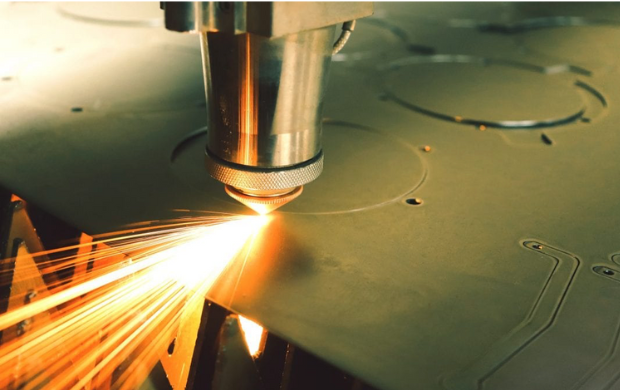Lasers are so powerful that you can use them to cut metal, vaporise tumours, and even shape diamonds. Yet, despite their incredible versatility and power, many people don’t know much about them. This is because lasers have been around for a long time—since the 1960s—and they’re not as flashy or cutting edge as something like the internet of things (IoT) might be. But that doesn’t mean companies worldwide aren’t using lasers in their daily operations. There are dozens of industries where laser technology plays a vital role in manufacturing processes and more. The use of laser technology has seen it embraced by businesses and industries across the globe. In fact:
The Automotive Industry
Lasers are utilized in the automobile sector for various tasks, including cutting metal, welding components, painting vehicles, and inspecting for flaws. They are multipurpose and may even be used to hone metal.
Lasers create a strong bond between two pieces of metal during welding by heating them up to melt into each other. Since clamps and welding torches are unnecessary, this procedure is substantially faster than conventional welding.
When you have an issue with your car (like a dent), lasers can help determine whether there’s anything wrong with the undercarriage of the vehicle before more expensive repairs are made.
The Construction and Manufacturing Industries
Lasers are used in the construction and manufacturing industries for precision cutting, drilling, welding, and measuring. Lasers can be used for the precision cutting of metal and other materials. They also drill holes in metal, stone, and other materials. An architect may use a laser cutter to precisely cut out wooden or acrylic window panes, for instance, for a construction project.
In addition to cutting through many different types of material with great accuracy, lasers can also be used to weld metal together instead of using traditional welding methods like arc welding or spot welding that require heat from an external source, such as electricity or gas sparks.
The Healthcare Industry
As you probably already know, lasers are used in the healthcare industry to treat various skin conditions. Lasers can treat acne and other skin blemishes, sun damage, and wrinkles. They’re also used for hair removal, or if you want that perfect bikini line—no more shaving!
But not all lasers target your body. There are even different types of eye surgeries that use lasers instead of traditional scalpel methods. And don’t forget about cancer treatments: one kind is called photodynamic therapy (PDT), which uses a targeted beam of light to destroy cancer cells without damaging healthy tissue surrounding them.
PDT has been around since the 1950s but wasn’t widespread until about 2000 when it became more accessible via laser equipment companies like Novus Medical Laser Systems Inc.
The Lighting Industry
In the lighting world, lasers are used for various applications. Lasers can produce multi-coloured displays and animations on buildings or monuments in public spaces. On a smaller scale, they’re also used in home theatres and gaming systems to project images onto walls and ceilings for users to interact with.
In offices and factories alike, lasers are often deployed as part of integrated security systems that monitor access points such as doors or windows; when someone tries to enter the premises without permission (or exit them without authorization), a beam from a laser scanner will detect their presence and alert authorities accordingly.
In this way, your favourite movie theatre might have employed a laser recently—but you may not have even noticed!
The Aerospace and Military industries
Lasers are also used in the aerospace industry to create satellites and track and guide them. These lasers can be fired from the ground or from a satellite itself. They can destroy missiles, aircraft, and other targets that get in their way.
Lasers are also used by military forces around the world for guidance and tracking purposes. In addition, lasers can help detect and track enemy aircraft and missiles through distance measuring or infrared detection methods.
The Textiles Industry
The textile business is one of the oldest in the world and has used lasers for decades. Textile makers use lasers to cut, stitch, or print materials such as cotton, wool, silk, and nylon. Clothing is a fundamental requirement that everyone has at some time in their life. Hence the textile sector is an essential aspect of many nations’ economies.
The leather industry is another major consumer of laser technology because leather products such as shoes, bags, and furniture require intricate cutting tools to create shapes. Lasers are also used to cut rubber for gaskets for machinery parts such as engines on planes or automobiles because they can make perfect holes with little waste material left behind from the cutting process.
The Energy and Mining Industries
The energy and mining industries use lasers to measure, detect, and cut materials. In fact, they use them so often that they’ve become essential parts of their operations. Most of this is due to the many benefits lasers offer them:
• Lasers can work in harsh environments without being destroyed by dust or water and can tolerate severe colds or heat. Consequently, they may be used in every climate or place on the earth (or beyond).
• They have no moving components that may fail over time. Therefore they don’t need much care.
• Laser beams can be focused precisely enough to cut through almost any material one might find in nature; from thick steel beams used for construction projects up through rocks into diamonds deep underground—there’s nothing these lasers cannot slice through! This makes them an incredibly versatile tool because it frees human workers from doing dangerous tasks such as cutting with saws or torches, which could cause injury if not done correctly.
Lasers Are Everywhere
In medicine, lasers deliver precise burns or cuts on the skin’s surface. They also heat up specific areas to kill malignant cells or destroy tumours. Lasers have even been used for cosmetic surgery, such as laser liposuction, which uses lasers to remove body fat without incisions or scalpel wounds (it may sound painful, but it’s a lot less invasive than traditional liposuction).
Lasers are also used in industry and manufacturing processes like cutting metal products and drilling holes into materials like wood or ceramics. In fact, most machines that use lasers can’t work without them—they’re essential components! If you look closely enough at any device with a screen display (like your computer monitor), there’s likely going to be a little red light shining out of somewhere within it; this is an indicator that there’s probably some kind of laser working inside too!
Lasers are helpful for more than just fun…
They can, in fact, be employed in a range of businesses. There is little doubt that lasers will continue to play a crucial role in our daily lives. Companies worldwide have developed new uses for lasers, ranging from agriculture to medicine to space exploration!








